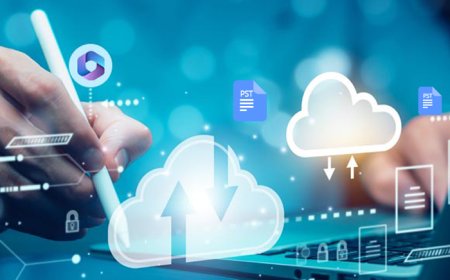A Comprehensive Guide to Healthcare Software Development Services in 2025
Explore a complete guide to healthcare software development services in 2025 and learn how modern solutions transform care delivery and operations.

Introduction to Healthcare Software Development
Healthcare software development has become a vital part of the medical industry, especially as technology advances rapidly. In 2025, the demand for innovative software solutions in healthcare is stronger than ever. These software services help hospitals, clinics, and healthcare providers manage patient information, improve care delivery, and streamline operations. Whether its electronic health records (EHR), telemedicine platforms, or health monitoring apps, healthcare software development is transforming the way care is delivered.
This guide will walk you through what healthcare software development means today, the key services involved, important technologies shaping the industry, and the benefits these software solutions bring to patients and providers alike.
What is Healthcare Software Development?
Healthcare software development is the process of creating digital tools and platforms specifically designed for the healthcare industry. These applications serve a variety of purposes such as patient management, diagnosis support, appointment scheduling, billing, and remote patient monitoring.
The goal is to make healthcare more efficient, accurate, and accessible. By digitizing many processes that were once paper-based or manual, healthcare software helps reduce errors, save time, and improve patient outcomes.
Types of Healthcare Software Services
Healthcare software development encompasses a broad range of services tailored to meet different needs in the healthcare ecosystem. Here are some common types:
Electronic Health Records (EHR) Systems
EHR systems digitize patients medical histories, treatments, test results, and medications. They allow healthcare providers to access patient information quickly and securely. This leads to better diagnosis, fewer mistakes, and improved coordination between specialists.
Telemedicine and Telehealth Platforms
These platforms allow patients to consult doctors remotely via video calls, chats, or phone calls. Telemedicine has become particularly important since the COVID-19 pandemic, helping patients receive care without visiting hospitals. Development of these platforms involves secure video streaming, patient scheduling, and virtual waiting rooms.
Medical Practice Management Software
This software helps clinics and hospitals manage daily operations like scheduling appointments, billing, insurance claims, and staff management. It makes the administrative side of healthcare smoother and more organized.
Mobile Health Apps
Mobile apps for patients offer services like appointment reminders, medication tracking, symptom checkers, and fitness monitoring. These apps encourage patients to take an active role in managing their health.
Remote Patient Monitoring Solutions
Wearable devices and connected sensors collect real-time health data such as heart rate, blood pressure, or glucose levels. The software processes this data and alerts doctors if any issues arise, enabling timely interventions.
Clinical Decision Support Systems (CDSS)
These are AI-powered tools that help doctors make better clinical decisions by analyzing patient data and medical research. They can suggest diagnoses, treatment plans, or flag potential drug interactions.
Key Technologies in Healthcare Software Development
Healthcare software development in 2025 uses several cutting-edge technologies to improve its services and capabilities. Some of the major technologies include:
Artificial Intelligence (AI) and Machine Learning
AI helps analyze large sets of health data quickly and accurately. Machine learning algorithms can predict disease outbreaks, personalize treatment plans, and detect anomalies in patient data that humans might miss. AI-driven chatbots also assist patients by answering common health questions 24/7.
Cloud Computing
Cloud platforms allow healthcare providers to store and access vast amounts of data securely and remotely. Cloud computing supports telemedicine services, data sharing between specialists, and disaster recovery.
Internet of Medical Things (IoMT)
IoMT refers to interconnected medical devices like wearables, implantables, and sensors that communicate data to healthcare systems in real time. These devices improve continuous patient monitoring and timely alerts.
Blockchain Technology
Blockchain offers a secure and transparent way to store patient records and manage data sharing with full privacy control. It prevents unauthorized access and ensures the integrity of sensitive health information.
Big Data Analytics
With so much patient data available, big data analytics tools help identify trends, improve treatment outcomes, and optimize hospital resources. These tools can also be used for medical research and public health management.
Read more: Top Benefits of Professional Healthcare Software Development Consultation
The Healthcare Software Development Process
Developing healthcare software involves several important steps to ensure the final product is safe, reliable, and user-friendly.
Requirement Gathering and Analysis
The first step is to understand what healthcare providers, patients, and other stakeholders need from the software. This involves detailed discussions and analysis of workflows, regulations, and technical requirements.
Design and Prototyping
Next, designers create user-friendly interfaces and workflows that make the software easy to navigate for doctors, nurses, and patients. Prototypes are often built to test ideas and get early feedback.
Development and Coding
This is the stage where developers write the actual code for the software. They use secure programming practices to protect sensitive health data and ensure compliance with healthcare regulations like HIPAA.
Testing and Quality Assurance
Healthcare software must undergo rigorous testing to identify bugs, security vulnerabilities, and usability issues. Testing ensures the software works correctly across devices and meets performance standards.
Deployment and Integration
Once tested, the software is deployed in the healthcare environment. Integration with existing hospital systems, devices, and databases is carefully handled to maintain seamless workflows.
Maintenance and Updates
After deployment, ongoing maintenance ensures the software continues to operate smoothly and adapts to changing healthcare needs and regulations.
Challenges in Healthcare Software Development
Developing software for healthcare is not without challenges. Some common obstacles include:
Regulatory Compliance
Healthcare software must comply with strict regulations to protect patient privacy and data security. Keeping up with changing laws like HIPAA in the US or GDPR in Europe can be complicated.
Data Security and Privacy
Healthcare data is highly sensitive. Developers must implement strong encryption, access controls, and secure data storage to prevent breaches.
Integration with Legacy Systems
Many healthcare providers still use older systems that can be difficult to integrate with new software solutions. Ensuring compatibility without disrupting services is tricky.
User Adoption
Doctors, nurses, and patients may be resistant to change or find new software difficult to use. Effective training and intuitive design are essential to drive adoption.
High Costs and Long Development Cycles
Creating robust, compliant healthcare software often takes significant time and investment, which can be a barrier for smaller healthcare providers.
Benefits of Healthcare Software Development Services
Despite the challenges, the benefits of healthcare software development services are profound:
- Improved patient care and safety through better data access and decision support
- Enhanced efficiency and reduced administrative burdens for healthcare staff
- Increased patient engagement and convenience via mobile apps and telemedicine
- Faster diagnosis and treatment enabled by AI and real-time monitoring
- Better data security and regulatory compliance
- Support for research and public health initiatives through big data analytics
Future Trends in Healthcare Software Development
Looking ahead to the rest of 2025 and beyond, several trends will shape healthcare software:
Personalized Medicine
Software will increasingly support treatments tailored to individual genetics and lifestyle, improving effectiveness.
Expanded Telehealth Services
Virtual care options will grow to cover more specialties and complex treatments, supported by advanced platforms.
Integration of AI in Routine Care
AI will become a regular assistant in hospitals, helping with everything from patient triage to robotic surgeries.
Greater Focus on Mental Health Apps
Software dedicated to mental health support and therapy will expand, reflecting growing awareness.
Increased Use of Wearables
More advanced wearable devices will continuously feed data to healthcare providers, allowing proactive care.
Choosing the Right Healthcare Software Development Partner
When selecting a company to develop healthcare software, it is important to consider their expertise in the healthcare domain, knowledge of relevant regulations, and experience with the technologies mentioned above. A good partner will also focus on user-friendly design, data security, and provide ongoing support after deployment.
Conclusion
Healthcare software development services in 2025 play a critical role in modernizing patient care and healthcare operations. By combining advanced technologies like AI, cloud computing, and IoMT with deep industry knowledge, these software solutions help healthcare providers deliver better, faster, and more personalized care. For organizations looking to improve their digital healthcare offerings, partnering with a skilled app development company can make all the difference. Such companies understand the unique needs of the healthcare sector and can deliver solutions that enhance patient outcomes and streamline workflows.
FAQs
What types of software are commonly developed for healthcare?
Common types include electronic health records (EHR) systems, telemedicine platforms, medical practice management software, mobile health apps, remote patient monitoring tools, and clinical decision support systems.
How does AI improve healthcare software?
AI analyzes large data sets to assist in diagnosis, predict health risks, personalize treatments, and automate patient interactions through chatbots.
Is healthcare software secure?
When developed properly, healthcare software uses strong encryption, access controls, and compliance with regulations like HIPAA to protect patient data.
What challenges do developers face in healthcare software projects?
Challenges include meeting regulatory requirements, ensuring data privacy, integrating with legacy systems, encouraging user adoption, and managing high development costs.
Why is telemedicine software important in 2025?
Telemedicine software allows patients to consult doctors remotely, increasing access to care, especially in rural or underserved areas, and reducing the risk of infections from in-person visits.





























